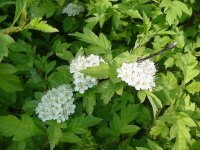Hawthorn blood-red - crataegus sanguinea pall.
Family Rosaceae - Rosaceae
Botanical characteristics. Family rose-colored. A shrub or a tree with a height of up to 5 m. The leaves are back-ovoid, fluffy, short-petioled with a wedge-shaped base and coarse-toothed margin. Small white odorous flowers are collected in thick corymbose inflorescences. Fruits are double-seeded, fleshy, orange-yellow or red. Blossoms hawthorn in May-June, fruits ripen in September.
There are several species of hawthorn. All kinds are used in medicine, have similar healing properties, so you can collect for medicinal purposes all kinds .
Spread. On the territory of our country grows 50 species of hawthorn, the most common of which is the hawthorn blood-red.
Used parts of the plant.
Flowers and fruits.
They contain acids (ursolic, chlorogenic, coffee), flavonoids, saponins, sorbitol, choline, tannins and essential oils.
Application. It is used as a sedative, lowering the excitability of the nervous system and improving the sleep remedy. Reduces the level of cholesterol in the blood, so it is prescribed for atherosclerosis. Hawthorn lowers blood pressure and improves coronary circulation, is used for hypertension, angina pectoris, myocarditis, cardiovascular insufficiency, I-II degree, in the climacteric period. Flowers and fruits of the plant reduce the permeability of blood vessels and capillaries. Flowers are stronger than fruits. Fruits in fresh form can be eaten. Hawthorn also has a weak diuretic effect.
Preparation.
On sale there is a tincture of hawthorn, it is taken for 30-50 drops 3 to 4 times a day before meals, liquid extract of hawthorn - 20-30 drops 3 times daily before meals with water.
At home, the infusion is prepared from flowers or dried fruits (pre-crushed fruits).
Daily dose - 1 tablespoon of flowers or 2 tablespoons of fruit to insist with 1.5 cups of boiling water, drink 3 times 30 minutes before eating.
It is used in homeopathy Sanguinea Зх, 3, 6, 9 with neurocirculatory dystonia according to hypertonic and cardiac type, with arrhythmia of functional genesis, mild forms of thyrotoxicosis, increased excitability and climacteric complaints accompanied by tachycardia.




Comments
When commenting on, remember that the content and tone of your message can hurt the feelings of real people, show respect and tolerance to your interlocutors even if you do not share their opinion, your behavior in the conditions of freedom of expression and anonymity provided by the Internet, changes Not only virtual, but also the real world. All comments are hidden from the index, spam is controlled.